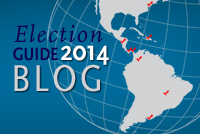2014 Election Blog: A Look at Gender Quotas ahead of Latin America's 2014 Legislative Votes
Will quota laws affect the number of female legislators elected in Bolivia, Brazil, Colombia, Costa Rica, Panama, and Uruguay this year?
A number of Latin American countries are preparing for congressional elections in 2014, and gender quotas will play a role in the number of women vying for legislative seats. In the region, 16 countries have quota systems for lawmakers, while one in four Latin American legislators are women. Globally, the Americas boasts the highest proportion of women lawmakers, just ahead of Europe.*
AS/COA Online looks at six countries holding legislative elections in 2014 that have mandated minimum thresholds for female congressional candidates.
Bolivia: An electoral law passed in 2010—which will be implemented during the 2014 elections—stipulates that candidate lists for the upper and lower houses of the Legislative Assembly must include equal numbers of men and women. For odd-numbered lists, preference is given to women. Currently, women encompass 22 percent of the Chamber of Deputies and 47 percent of the Chamber of Senators.
Brazil: The country’s 1997 electoral law requires at least 30 percent of Chamber of Deputies candidates to be female. A September 2009 amendment to the legislation requires parties to allocate at least 10 percent of advertising and 5 percent of public campaign funding to promote women’s participation in the political sphere. However, women currently make up only 9 percent of the Chamber of Deputies and 16 percent of the Senate.
Colombia: A gender quota law passed in July 2011 requires 30 percent of candidates for all publicly elected offices to be women. While 2014 will mark the first national legislative election with the law in place, the quota helped boost the number of female candidates from 20 percent to 35 percent during the 2011 local elections. The legislation also reserves 5 percent of state funding for political parties based on the number of women a party has elected to public office. Overall, women make up 16 percent of Congress, with 13 percent of the lower house and 17 percent of the upper house represented by female lawmakers.
 Costa Rica: A 2009 electoral law stipulates that 50 percent of all candidates for public office must be women. It also requires political parties to promote gender equality in the party structure, such as mandating that they list their candidates by alternating men’s and women’s names. Costa Rica has one of the highest percentages of women lawmakers in the Americas: 39 percent of the unicameral legislature is female.
Costa Rica: A 2009 electoral law stipulates that 50 percent of all candidates for public office must be women. It also requires political parties to promote gender equality in the party structure, such as mandating that they list their candidates by alternating men’s and women’s names. Costa Rica has one of the highest percentages of women lawmakers in the Americas: 39 percent of the unicameral legislature is female.
Panama: A September 2012 amendment to the country’s electoral code states that women must encompass at least 50 percent of candidacies for primaries and internal party elections. However, if less than 50 percent of female candidates run for office, the legislation permits men to fill the vacant slots. Also, there is no mandate requiring a threshold of female candidates in national or local elections. Women make up only 9 percent of the unicameral legislature.
Uruguay: Legislation passed in 2009 established a gender quota in effect only for the 2014 national elections and 2015 local elections. On all candidate lists for public office, men and women must be represented in every three places—either throughout the whole list or in the first 15 spots. When only two seats are up for grabs, one of the two candidates must be a woman. Women currently make up 14 percent of the lower house and 13 percent of the upper house of Congress.
*Editor's note: The original version of this blog post stated that the Americas has the second-highest proportion of women lawmakers after Europe. The Americas has a higher proportion of legislators than Europe and is only second to Nordic countries when those countries are take separately from Europe.







